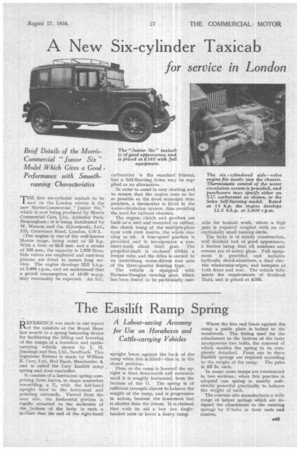A New Six-cylinder Taxicab
Page 57

If you've noticed an error in this article please click here to report it so we can fix it.
for service in London
Brief Details of the MorrisCommercial "Junior Six Model Which Gives a Good. Performance with Smooth
running Characteristics
THE first six-cylinder taxicab to be
seen on the London streets is the new Morris-Commercial "Junior Six,"which is now being produced by Morris Commercial Cars, Ltd., Adderley Park, Birmingham ; it is being distributed by W. Watson and Co. (Liverpool), Ltd., 132, Grosvenor Road, London, S.W.1.
The engine is one of the well-known Morris range, being rated at 15 h.p. With a bore of 63.5 ram. and a stroke of 102 nun., the capacity is 1.938 litres. Side valves are employed and cast-iron pistons are fitted to ensure long service. The engine develops 32.5 b.h.p. at 3,400 r.p.m., and we understand that a petrol consumption of 18-20 m.p.g. may reasonably be expected. An S.U. carburetter is the standard fitment, but a Self-Starting Solex may be supplied as an alternative.
In order to assist in easy starting and to ensure that the engine runs so far as possible at the most economic temperature, a thermostat is fitted in the water-circulation system, thus avoiding the need for radiator shutters.
The engine, clutch and gearbox are built as a unit and mounted on rubber, the clutch being of the multiple-plate type with cork inserts, the whole running in oil. A four-speed gearbox is provided and it incorporates a constant-mesh silent third gear. The propeller-shaft is enclosed within a torque tube, and the drive is carried to an undershing worm-driven rear axle of the three-quarter floating type.
The vehicle is equipped with Burman-Douglas steering gear, which has been found to be particularly suit able for taxicab work, where a high gear is required coupled with an exceptionally small turning circle.
The body is of sturdy construction, well finished and of good appearance, a feature being that all windows and screens are of safety glass. Full equipment is provided and includes hydraulic shock-absorbers, a dual electric windscreen-wiper, and bumpers at both front and rear. The vehicle fully. meets the requirements of Scotland Yard, and is priced at 4385.




























































































